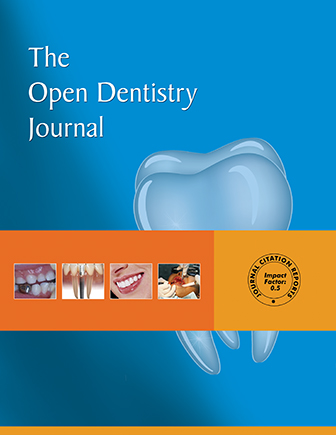All published articles of this journal are available on ScienceDirect.
Usability and Satisfaction Research of the Perio-based Mobile Application in Healthy, Gingivitis, and Periodontitis Subjects: A Preliminary Study
Abstract
Background
Plaque accumulation in teeth-supporting tissues can lead to periodontitis. Periodontitis worsens due to low Oral Health Literacy (OHL). To address this issue, a Perio-based mobile application was created. To further solidify its implementation, market research is needed to assess its long-term sustainability in Indonesia.
Objective
This study analyzed the effect of age, education, and periodontal status on Perio-based mobile application usability and satisfaction.
Methods
This survey-based research was conducted on 20 women aged 25-55 years who were introduced to the Perio-based mobile application. While a five commands technique did the usability test, the satisfaction test was completed through a validated questionnaire. The data were then statistically analyzed.
Results
Education level significantly affects the level of Perio-based mobile application usability (p= 0.025, Correlation Coefficient:0.478). Further, the Perio-based mobile application was easy to use in the late adult group (36-45 years), undergraduate education, and periodontitis status. The highest satisfaction was seen in the late elderly group (46-55 years), high school education, and the gingivitis group. Age group and periodontal status had no significant effect on application satisfaction; however, a notable association was observed between education level and the usability of test results.
Conclusion
Overall, there were no differences in the results of the application usability and user satisfaction at different ages, educational levels, and periodontal status. Perio-based mobile applications can be improved by developing an iOS version and adding autonomous features.
1. INTRODUCTION
Periodontitis is a disease of the supporting tissues of the teeth due to plaque accumulation. Indonesian Basic Health Research (2018) reports that seven out of ten in Indonesia suffer from periodontitis [1]. Periodontitis is caused by poor oral hygiene, smoking habits, and comorbidities such as diabetes mellitus [2, 3]. Periodontitis gets worse every year due to the very low Oral Health Literacy (OHL) of the patients. Residing in Jakarta, the capital city, does not necessarily guarantee access to quality health services or adequate health education. Rikawarastuti (2016), in Pondok Labu, South Jakarta, reported that two of her subjects experienced periodontitis during pregnancy [3, 4]. Both subjects had low OHL, so they did not know about its manifestations [4]. If this continues, it could cause premature birth, fetal infection, and 19.2 times the risk of Low-Birth-Weight babies in pregnant women [5]. Periodontitis, as a manifestation of diabetes mellitus (DM), can negatively impact the quality of life and future well-being of the nation’s children [6]. Until now, the government has made various efforts to overcome this problem. The government has guided dental and oral health efforts in the Indonesian Ministry of Health Regulation No. 89 of 2015. The Ministry of Health has also created a ‘Gerakan Masyarakat Hidup Sehat’ to call for periodic health checks [4]. However, there are no specific rules, gestures, or applications regarding periodontitis.
Mobile apps have been developed to support the healthcare system by facilitating patients’ appointments, screening patients, and enhancing diagnosis [5]. It also benefits the dentist and medical personnel in evaluating the long-term success of periodontal treatment even more [5, 6]. Emerging studies indicate that mobile health (mHealth) applications are effective in promoting behavior change, improving oral hygiene, and supporting periodontitis therapy [7, 8]. Perio-based mobile application, PerioUICare, is integrated for solutions to health problems in the periodontal field. This application with the teletriage approach is offered as a specific solution for periodontitis patients to improve the OHL of the Indonesian people [6]. This application has features such as a reminder every morning and evening, education three times a week, medical history records, and reminders for the next visit. The use of a Perio-based mobile application has been tested in a pilot study conducted on 20 women aged 25-55 year. However, the researchers did not know the patient's views regarding its usability and suitability. Therefore, research on individuals who participated in the previous study was needed as market research so that Perio-based mobile application can be developed and used for long-term sustainability in Indonesia. This study focused on non-smoker women to give homogenous characteristics and reduce the resulting bias.
The aim of this study was to analyze the effect of age, education, and periodontal status on Perio-based mobile application usability and satisfaction. The purpose of the usability test was to assess the user interface and user experience of the Perio-based mobile application so that all features can be accessed by patients. However, the satisfaction test aims to test the alignment between patient needs and the application provided.
2. MATERIALS AND METHODS
This survey-based research study design was designed with 20 subjects. The usability test was conducted by assigning five specific tasks to each subject, while satisfaction was assessed through a structured questionnaire. Inclusion criteria for the study included female patients aged 25–55 years, residing in Jakarta, active users of the Perio-based mobile application, Android smartphone users, individuals in the initial phase of periodontal care, and those who provided informed consent.
The exclusion criteria of this study were smokers, systemic diseases, illiterate people, special needs, and pregnant women. The data were then analyzed by SPSS with the Kendal Test. The research protocol has been approved and registered to The Ethics Committee of the Faculty of Dentistry, Universitas Indonesia (01/Ethical Approval/FKGUI/I/2022). The study was conducted and reported in accordance with the Consolidated Standards of Reporting Trials (CONSORT) guidelines. The research procedure followed was in accordance with the ethical standards of the committee responsible for human experimentation (institutional and national), and with the Helsinki Declaration of 1975, as revised in 2013.
The sample size calculation in the study used the software G*Power43 version 3.1.9.7 (Heinrich Heine Universität Düsseldorf) with an effect size of 0.8. The minimum sample size obtained was 10 subjects for each test group and control group. Therefore, 20 subjects will also be given surveys and interviewed in this research. Considering this investigation focuses on a preliminary study, the limited number of subjects is acceptable.
For the usability test, participants were instructed to complete five tasks, each representing a key feature of the Perio-based mobile application: (1) open the information from the last visit; (2) open the morning reminder; (3) access one of the educational content modules; (4) retrieve first-visit medical data; and (5) submit a complaint through the application. Usability for each feature was categorized based on task completion time: high usability if completed in under 15 seconds, moderate usability if under 30 seconds, and low usability if the task was difficult to perform or exceeded 30 seconds.
For the satisfaction test, subjects were also given a survey with five questions: 1. This application is useful in adding insight and keeping your teeth and mouth clean; 2. The educational features and content in this application are quite easy to understand; 3. This application does not interfere with your daily activities; 4. You are satisfied with using this application; 5. You are willing to recommend the use of this application to people around you. Each question has a scale between 1 to 5. The highest subject satisfaction is at number 1 and the lowest is at number 5. All questions are accumulated and averaged.
The processing of data collection results was analyzed with SPSS software version 26 (IBM, Chicago, IL, USA). Demographic data is shown in the table and graphs. The correlation test used was the Kendall Test with p-value <0.05 considered significant (Fig. 1).
3. RESULTS
The study included 20 participants. The sociodemographic background of the subjects was diverse. Based on the age distribution (Table 1), there was 1 subject aged 26-35 years, 9 subjects aged 36-45 years, and 10 subjects aged 46-55 years. In this study, the early elderly (46-55 years) dominated the age group. Based on the distribution of education, the subjects were divided into 13 subjects: high school graduates, 1 subject diploma graduate, 5 subjects bachelor graduates, and 1 master graduate. Based on the periodontal status, the subjects were divided into 2 healthy subjects, 9 gingivitis subjects, and 9 periodontitis subjects.
The usability results showed that 10 subjects found the Perio-based mobile application easy to use, 8 subjects reported it as usable, and 2 subjects found it difficult to use. Regarding user satisfaction, 2 subjects reported low satisfaction, 9 reported moderate satisfaction, and 9 reported high satisfaction (Table 2).
3.1. Usability Test
The results of the ease of use of the Perio-based mobile application were reviewed based on age group (Fig. 2), educational level (Fig. 3), and periodontal status (Fig. 4).
In the young adult group (age 26-35), 1 subject stated that the application usability was high. At the late adult group (age 36-45), 5 subjects stated the usability was high and 5 subjects stated that it was moderate. Finally, at the early elderly group (age 46-55), 4 subjects stated the usability was high, 3 subjects stated moderate usability, and 2 subjects stated low usability. Based on the results above, the age group is dominated by the late adult group.
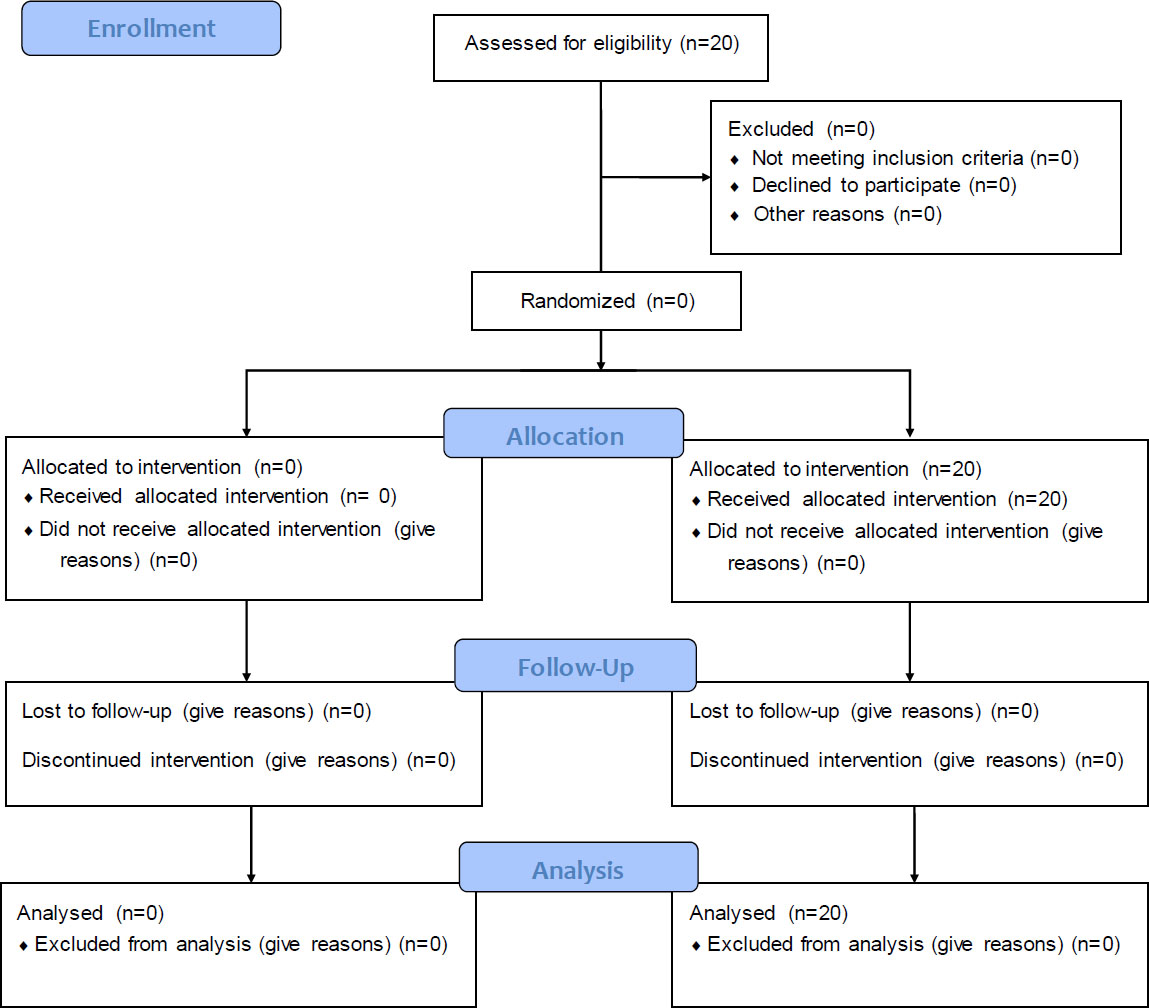
The design of this preliminary study followed CONSORT guidelines.
Based on educational level, 10 subjects perceived the application's usability as high, 8 as moderate, and 2 as low. There were 4 high usability, 7 moderate usability, and 2 low usability were reported in a senior high school group. Meanwhile, from the diploma graduate, 1 declared it was easy to use. Of the bachelor graduates, 4 thought the usability was high and 1 moderate usability. Finally, at the master’s graduates, 1 subject thought it was easy to use. Based on the results of educational level, the group is dominated by high school graduates. The results in this group varied from easy to difficult but were dominated by 7 subjects who said it could be used. Researchers are aware that there were two 2 subjects from high school education who found this application difficult to use, which is not available at other levels of education. In the bachelor graduates’ group, the average answer is high and moderate usability.
| Variable | N (subject) | Percentage (%) |
|---|---|---|
| Age | - | - |
| Young Adult | 1 | 9 |
| Late Adult | 9 | 41 |
| Early Elderly | 10 | 50 |
| Education | - | - |
| High School | 13 | 65 |
| Diploma | 1 | 5 |
| Bachelor | 5 | 25 |
| Master | 1 | 5 |
| Periodontal Status | - | - |
| Healthy | 2 | 10 |
| Gingivitis | 9 | 45 |
| Periodontitis | 9 | 45 |
| Variable | N (subject) | Percentage (%) |
|---|---|---|
| Usability | - | - |
| High | 10 | 50 |
| Moderate | 8 | 40 |
| Low | 2 | 10 |
| Satisfaction | - | - |
| High | 9 | 45 |
| Moderate | 9 | 45 |
| Low | 2 | 10 |
At the level of periodontal status, 1 thought the usability was high and 1 moderate from the healthy. In the gingivitis group, the usability was 4 subjects high, 4 subjects moderate, and 1 subject low. In the periodontitis group, 5 subjects thought the usability was high, 3 moderate, and 1 low. According to the available results, the periodontal status influences the perception of the usability of the application. The dominating group is 5 subjects with periodontitis who feel that this application is easy to use. However, there was 1 subject from the periodontitis and gingivitis group who found this application difficult. In addition, the healthy group was only represented by 2 subjects who had two different opinions, namely high usability and moderate, so it could not be concluded. Improvements to the user interface and user experience (UI/UX) of the Perio-based mobile application are necessary, as the primary target users are patients with periodontitis.
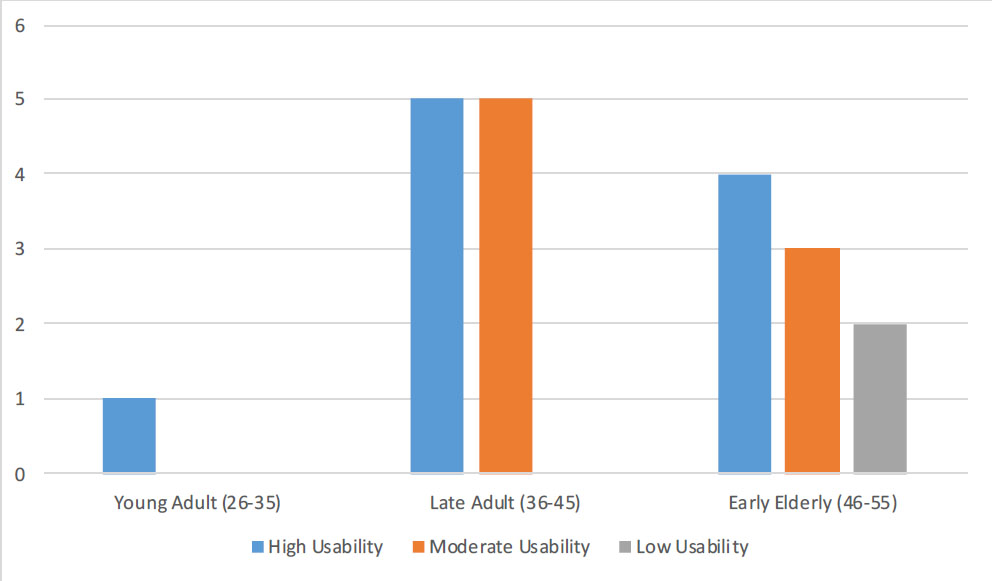
Distribution of perio-based mobile application usability test according to age.
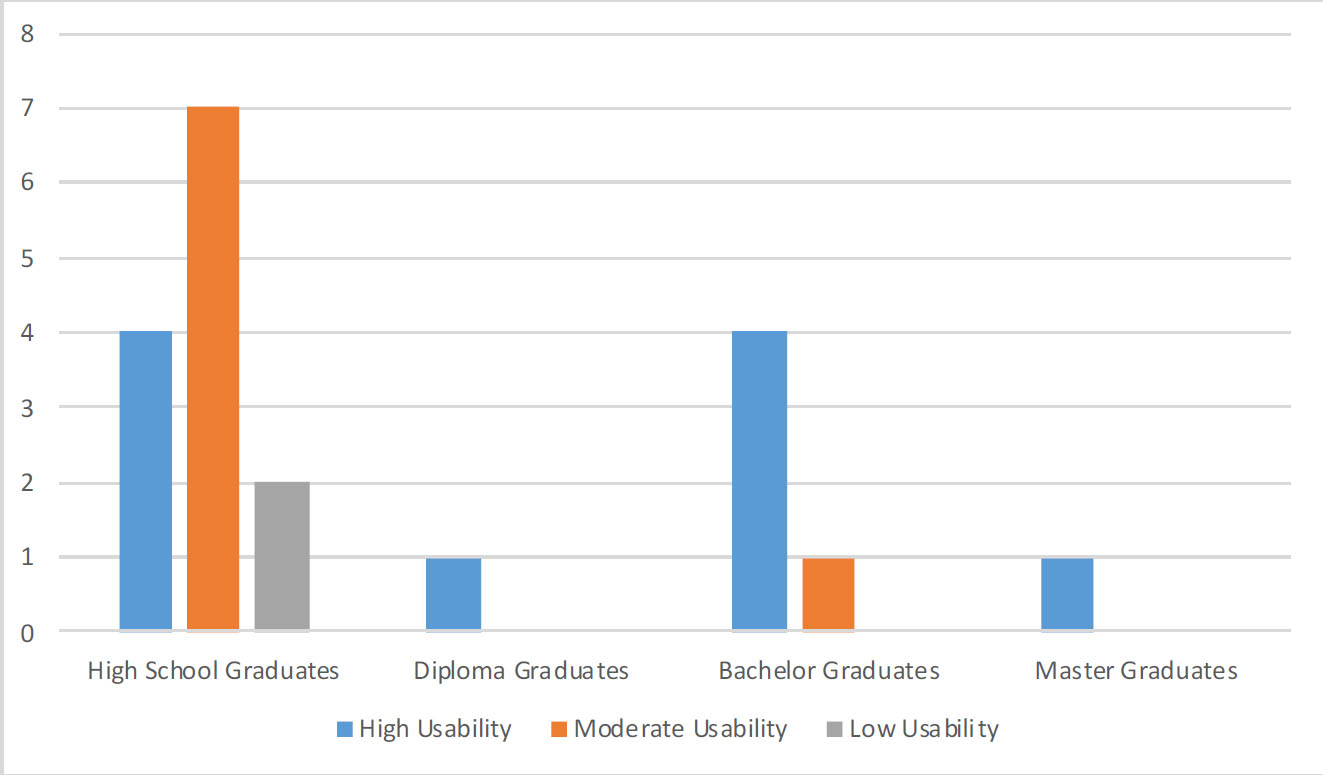
Distribution of perio-based mobile application usability test according to education level.
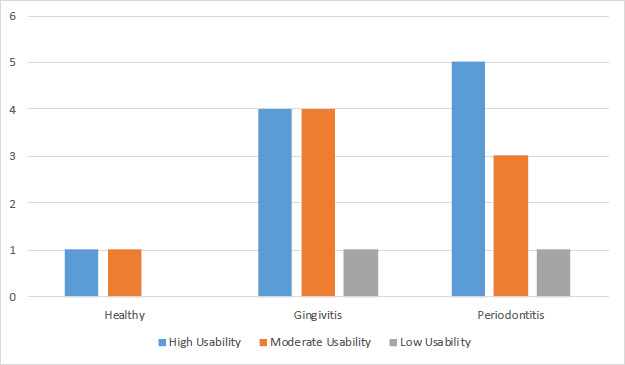
Perio-based mobile application usability test related to periodontal status.
3.2. Satisfaction Test
The results of Perio-based Mobile Application satisfaction were reviewed based on age group (Fig. 5), educational level (Fig. 6), and periodontal status (Fig. 7).
In the young adult group (age 26-35), 1 subject was highly satisfied. The late adult group (age 36-45) thinks 4 subjects have high satisfaction and 5 subjects have moderate. Whereas in the early elderly (age 46-55), 4 subjects were satisfied, 4 subjects were moderately satisfied, and 2 subjects were dissatisfied. Based on the above results, the more dominant age group is the early elderly, namely in the age range of 46-55 years, as many as ten subjects. Within this age group, subject satisfaction was divided into 4 satisfied, 4 moderate, and 2 dissatisfied. This age group is more likely to be satisfied and moderate on the application.
Among the senior high school graduates, 4 subjects said they were satisfied, 7 said they were moderately satisfied, and 2 subjects were dissatisfied. At the diploma, 1 subject is satisfied. In the bachelor graduates’ group, 3 subjects thought they were satisfied, and 2 subjects thought they were moderate. Meanwhile, in the master’s graduate group, 1 subject was satisfied. In the education level group, subjects were dominated by high school graduates, namely 13 subjects who were more likely than 7 subjects to think moderate satisfaction.
At the level of periodontal status, 1 subject said they were satisfied and 1 subject thought they were moderately satisfied. At the level of the gingivitis group, 5 subjects said they were satisfied, 3 subjects thought they were moderate, and 1 subject said they were not satisfied. Among the periodontitis group, 3 subjects reported high satisfaction, 5 reported moderate satisfaction, and 1 reported low satisfaction.

Distribution of perio-based mobile application usability test related to age.
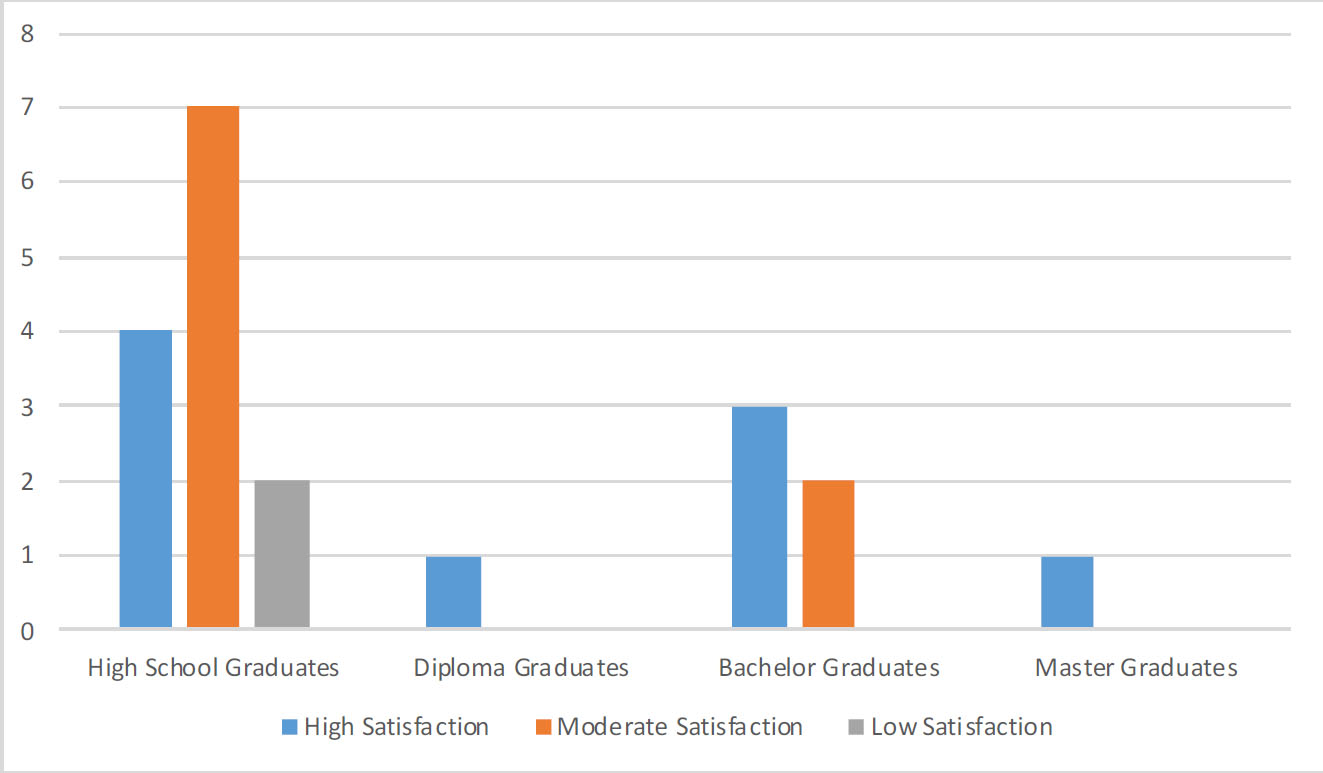
Distribution of perio-based mobile application usability test related to education level.
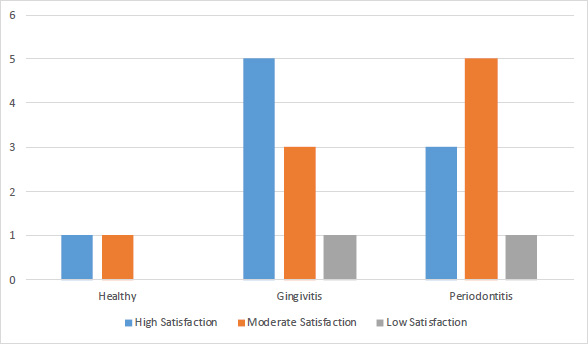
Distribution of perio-based mobile application usability test related to periodontal status.
SPSS analytic test was used to see the correlation between the two variables to answer the hypothesis. In this study, the null hypothesis (H0) used was “there is no effect of the independent variables on the results of the dependent variable”. The null hypothesis was accepted if the value of p> 0.05. The variables used in this study were all categorical. The correlation test used was the Kendall Test.
Based on educational level, 10 subjects rated the usability as high, 8 as moderate, and 2 as low. There were 4 high usability, 7 with moderate usability, and 2 low usability declared from senior high school. Meanwhile, from the diploma graduate, 1 declared it was easy to use. Among the bachelor graduates, 4 thought the usability was high and 1 moderate usability. Finally, at the master's graduates, 1 subject thought it was easy to use. Based on the results of educational level, the group is dominated by high school graduates. The results in this group varied from easy to difficult but were dominated by 7 subjects who said it could be used. Researchers are aware that there were 2 subjects from high school education who find this application difficult to use, which is not available at other levels of education. In the bachelor graduate group, the average answer is high and moderate usability.
Based on Table 3, there is no statistically significant correlation between age groups and usability results. A correlation coefficient value of -0.285 means a weak linear relationship is the opposite. The value of p=0.478 indicates that the null hypothesis is accepted. Therefore, it can be concluded that there is no influence of age group on the Perio-based mobile application usability results. There is a statistically significant correlation between educational level and usability results. The correlation coefficient value of 0.478 means that the linear relationship is in the same direction. The value of p=0.025 indicates that the null hypothesis is not accepted. Therefore, it may be considered that there is an effect of education level on the Perio-based mobile application usability results though the sample size is small. As seen in Table 3, there is no statistically significant correlation between periodontal status and usability results. A correlation coefficient value of 0.52 means a weak linear relationship in the opposite direction. The value of p=0.809 indicates that the null hypothesis is not accepted. Therefore, it can be concluded that there is no effect of periodontal status on the results of Perio-based mobile application usability.
| Usability Test | Correlation Coefficient | p-value |
|---|---|---|
| Age Group | -0.285 | 0.189 |
| Education Level | 0.478 | 0.025* |
| Periodontal Status | 0.52 | 0.809 |
Based on Table 4, there is no statistically significant correlation between age groups and satisfaction results. A correlation coefficient value of -0.221 means a weak linear relationship is the opposite. The value of p=0.307 indicates that the null hypothesis is not accepted. Therefore, it can be concluded that there is no association of age group on the Perio-based mobile application satisfaction results. There is no statistically significant correlation between educational level and satisfaction results. The correlation coefficient value of 0.375 means that the linear relationship is in the same direction. The value of p=0.078 indicates that the null hypothesis is accepted. Therefore, it can be concluded that there is no association between education level on the Perio-based Mobile Application satisfaction results. As seen in Table 4, there is no statistically significant correlation between periodontal status and satisfaction results. A correlation coefficient of 0.375 indicates a positive linear relationship, meaning that as one variable increases, the other tends to increase as well. The value of p=0.424 indicates that the null hypothesis is accepted. Therefore, it can be concluded that there is no effect of periodontal status on the results of Perio-based mobile application satisfaction.
| Satisfaction Test | Correlation Coefficient | p-value |
|---|---|---|
| Age Group | -0.221 | 0.307 |
| Education Level | 0.375 | 0.078 |
| Periodontal Status | -0.171 | 0.424 |
4. DISCUSSION
Perio-based mobile application is the first tele-dentistry focusing on periodontal in Indonesia used at Dental Hospital, Faculty of Dentistry, Universitas Indonesia [6]. This application targets users with periodontal problems and aims to improve clinical outcomes, knowledge levels, and user habits in maintaining dental and oral hygiene. With the integration of this application, it is hoped that it will reduce costs by reducing the frequency of patients going to the dentist due to the pandemic. This application is integrated to improve education and the quality of life of the community to support the Industrial Revolution 4.0. The display of the Perio-based mobile application is seen in Fig. (8).
The Perio-based mobile application incorporates a triage concept to assist in prioritizing patient care based on the severity of periodontal conditions [6]. The application categorizes users according to diseases and precarious conditions. Users were divided into three groups based on healthy, gingivitis, and periodontitis. Each user gets specific content depending on the group the subject is placed in. Dental Health Education is an educational process that aims to improve dental and oral health. The purpose of providing education is to increase knowledge and change patient behavior for the better, as well as dental and oral health actions that can change to healthier behavior. Chawlowska et al., (2022) reported that educating parents has a major role in improving the education and health of their children's teeth and mouth. Therefore, it was found that the higher the dental health education to parents, the higher the dental and oral health education of their children [2, 7-9]. Considering that the world is affected by periodontal disease, good education is appropriate to address these conditions [10-14]. On the other hand, periodontitis is a multilayered disease that requires different educational approaches according to the degree of severity [15]. Given these burdens and limitations in real-world settings, there is a clear need for improvement. Mobile applications have been created that assist the health system with patient scheduling, and patient screening and, in some cases, even improve the accuracy of the diagnosis [5]. It also helps the dentist and other medical staff in assessing the effectiveness of periodontal therapy even further [5, 6]. Recent studies indicate that mobile-based health applications, or mHealth, are more effective at achieving behavioral changes, such as improving oral hygiene and compliance in periodontitis treatment [7, 8]. Therefore, a health intervention system according to periodontitis severity classification (teletriage) is presented in the Perio-based mobile application [16-20].
The usability test was carried out to test the effectiveness of the application display or user interface and the user experience using the Perio-based mobile application. The purpose of conducting this usability test was to see in the field whether the design of the application’s usability. The purpose of this study was to assess whether all services provided through the Perio-based mobile application are accessible and understandable to users. The integration of the application into periodontal treatment must ensure that it supports and facilitates the healing process. The application was evaluated based on user age group, educational level, and periodontal status.
Based on the SPSS analysis listed in Table 3, there was a moderate and unidirectional effect on the level of education on the Perio-based mobile application usability test. This was indicated by the value of the correlation coefficient and p-value. However, there was no effect between age groups and periodontal status on the ease of use of the Perio-based mobile application test. This means that the higher the level of education, the easier it was to use the Perio-based mobile application. Along with that, the usability challenges faced by participants with lower education levels and this is addressed by simplifying the app design so everyone can address these barriers.
When compared with the hypothesis, there is no correlation regarding the ease of use of the Perio-based mobile application based on age level, education level, and periodontal status. The Perio-based mobile application was more applicable to use in the late adult age group (36-45 years), undergraduate education level, and periodontitis group. This app was considered suitable because the development of periodontal disease started in the early 40s. In addition, the user interface design was suitable on target with periodontitis users. However, due to the small sample size, an improvement should be made to enhance usability for high school graduates, as some reported difficulties in using the application. This consideration was based on the fact that many of the subjects were high school graduates [1, 3].
Satisfaction test was conducted to see the subject's perception with the Perio-based mobile application as one of the steps to facilitate healing. The purpose of conducting this satisfaction test was to see in the field the suitability of the Perio-based mobile application with the needs of the subject. From the perspective of the subject, downloading the Perio-based mobile application has the hope of gaining cognitive, psychomotor, and clinical improvement knowledge. This research was conducted to check that all services provided by Perio-based mobile applications can meet these needs. The placement of a Perio-based mobile applica-
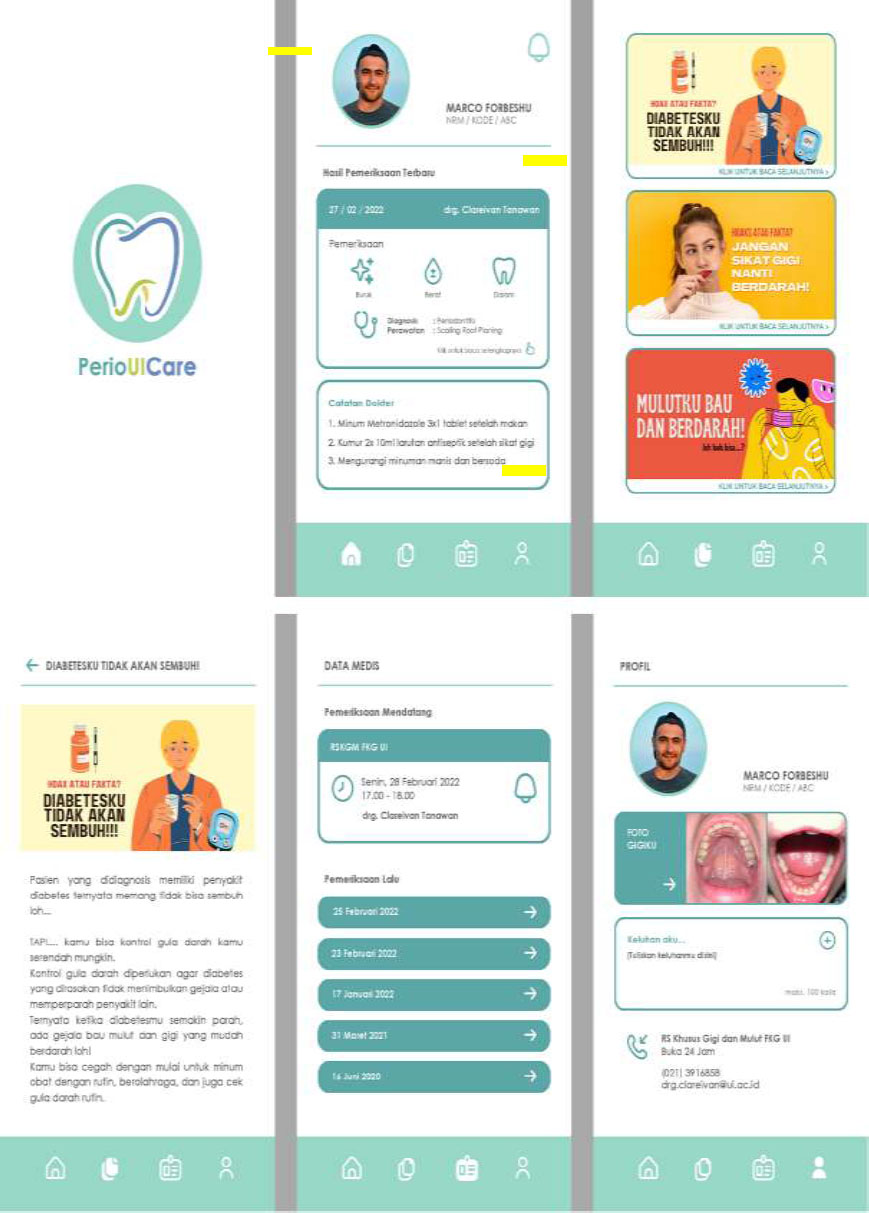
Mock-up of the perio-based mobile application.
tion in the periodontal treatment must ensure that it facilitates the healing of the subjects. This application was reviewed based on age group, education level, and periodontal status.
Based on the SPSS analysis shown in Table 4, there was no effect between age groups, educational level, and periodontal status on the Perio-based Mobile Application satisfaction test. This was indicated by the value of the correlation coefficient and p-value. The Perio-based mobile application satisfaction score was the preference of the subject regarding the health needs presented in the Perio-based mobile application. Therefore, the satisfaction test requires several other variables and a more accurate and detailed type of test so that the development can be more precise.
When compared with the hypothesis, there is no correlation in perceptions regarding the satisfaction of the Perio-based mobile application based on age group, educational level, and periodontal status. The highest satisfaction was reported by the late elderly group (46-55 years), high school graduates, and participants with gingivitis. Based on the age group, this application was very appropriate because the targeted age usually has developed periodontal disease. But it can be improved so that the initial elderly group can also feel satisfied. Although the level of education was appropriate, the satisfaction of the periodontal status group can be reviewed and improved. The gingivitis user was very important and has a key because the success of this application can be seen in the gingivitis group. If the user's needs can be accommodated in this application, the gingivitis would be healthy. Whereas in the gingivitis group, those who were dissatisfied and felt unfulfilled would develop periodontitis. This is very good, but the periodontitis group must also be satisfied with the application, considering that the worst-affected group needs this application the most [1, 3].
This research has many advantages. First, this research was conducted through direct interviews so that research subjects could express and explain the obstacles they experienced more easily than using a questionnaire. Through an open question, the subject conveyed that there were several administrative constraints such as name, username, and password so that in the future, they could be given autonomy to change personally. Second, the selected subjects were very cooperative in following the research steps and provided various constructive inputs. The subject was very cooperative when asked to come for the second meeting of his research in a timely manner so that the research could finally run smoothly. In addition, the subject also hopes that this application can be developed with various features that will further help periodontitis patients. Third, the Perio-based mobile application can be well received by research subjects and has a very large development space in Indonesia. In the future, improvements for the Perio-based mobile application are needed because the main target of making this application was periodontitis patients so that it can reach 100% easily [1, 4-6, 21-26].
CONCLUSION
Based on the results and discussion carried out, there are differences in the results of usability (task-based efficiency) and user satisfaction (subjective perception) at different ages, educational levels, and periodontal status. Descriptive results showed that the app was easier to use in the late adult age group (36-45 years), undergraduate education level, and periodontitis group. The highest satisfaction was reported by the late elderly group (46-55 years), high school graduates, and participants with gingivitis. Its implementation needs to be continued in Indonesia, especially in personalization features or simplified navigation for less tech-savvy users. The clinical significance of this study brings a fundamental basis for the development and implication of this app in a tailored consideration.
This application can be improved by allowing users to manage registration and administrative features independently. In addition, further study plans to conduct research with a larger sample size with more diverse demographics and develop a website-based platform. This issue has been analyzed to be the limitation of the present study. Nevertheless, the use of Perio-based mobile application has many factors such as educational background, socio-economic level, and the level of understanding of technology need to be explored again.
AUTHORS’ CONTRIBUTIONS
The authors confirm contribution to the paper as follows: B.S.: Writing, reviewing and editing; A.K.R.: Data collection; H.R.: Methodology; V.H., Y.S.: Data curation; M.R.P.: Investigation; M.M.P.: Validation. All authors reviewed the results and approved the final version of the manuscript.
ABBREVIATION
| DM | = Diabetes Mellitus |
ETHICS APPROVAL AND CONSENT TO PARTICIPATE
The Dental Research Ethics Committee of the Faculty of Dentistry at Universitas Indonesia has granted approval for the ethical statement. The approval is documented with letter number 01/Ethical Approval/FKGUI/I/2022
HUMAN AND ANIMAL RIGHTS
All procedures performed in studies involving human participants were in accordance with the ethical standards of institutional and/or research committees and with the 1975 Declaration of Helsinki, as revised in 2013.
AVAILABILITY OF DATA AND MATERIALS
The data supporting the findings of the article will be available from the corresponding author [B.S] upon reasonable request.
FUNDING
This research received financial support through a grant from the Ministry of Education and Culture, Republic of Indonesia (KEMDIKBUDRISTEK) No: 195/E5/PG.02.00.PT/2022.
ACKNOWLEDGEMENTS
The authors would like to acknowledge the Indonesian Society of Periodontology, Jakarta Raya branch (IPERI KOMDA JAYA) and Division of Periodontology, Graduate School of Medical and Dental Sciences, Niigata University, Japan, as our partners in this study. Further, we appreciate facility support from the Dental Teaching Hospital, Faculty of Dentistry, Universitas Indonesia.

